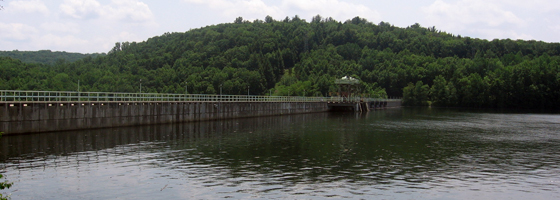Lake Lillinonah buoy supplies data for researchers, credibility for advocates

Lake Lillinonah has a garbage problem.
The lake sits behind a dam on the Housatonic River and is the first large reservoir encountered by debris that washes into the river upstream. The lake, Connecticut’s second largest, acts as the watershed’s catch basin for stream-bound refuse, natural or otherwise.
“Anything you can think of, we found it,” said Greg Bollard, executive board member of Friends of the Lake, a community building and water quality advocacy group for Lake Lillinonah. “From refrigerators to propane tanks to engines to vehicles to docks to boats.”
Depending on how the lake’s level is manipulated in support of hydroelectricity generation at the dam, the debris can range from thick enough to hamper boat navigation to “not a stick on the water,” Bollard said. But there is one piece of hardware that Friends of the Lake is happy to keep floating out there. In 2011, the group launched a water quality monitoring buoy that could help unravel the mystery behind another issue on the water: algal blooms.
The lake is eutrophic and algal blooms are a big concern, said Jen Klug, an associate professor of biology at nearby Fairfield University. Klug has worked closely with Friends of the Lake on the buoy project and other monitoring efforts.
What triggers the blooms isn’t clear, Klug said. Blooms are often a symptom of excess nutrients, which Lake Lillinonah has in abundance thanks to loading from the basin’s wastewater treatment plants, lawn fertilizers and stormwater. But it seems to be more complicated than that. The lake’s phosphorus levels are generally high enough to support an algal bloom, but algae isn’t always blooming.
So what else could be causing the blooms? One possibility that Klug and other researchers are looking into is the lake’s mixing patterns. For example, the lake’s layers of warm and cool water could play a role in either flushing algae out of the system or churning an extra dose of nutrients up from the bottom and fueling algae growth at the surface.
But as an impounded river, mixing can be highly variable and the layers can change quickly, making it a difficult thing to track.
“For example, during the rain following Hurricane Irene last fall, the lake completely mixed in the course of a couple hours,” Klug said.
That’s where the buoy comes in. A string of sensors hanging from the float measures temperature at 15 depths, every 15 minutes. That kind of high-frequency monitoring can give researchers a better picture of temperature stratification on a dynamic system like Lake Lillinonah.
The buoy is also measuring dissolved oxygen, conductivity, pH, chlorophyll and phycocyanin near the surface and dissolved oxygen near the bottom. Researchers don’t yet have enough data to draw any conclusions about the blooms, but they are learning things about the lake. In the dry July of 2011, for example, the buoy data showed the lake was strongly stratified despite spot sampling that suggested otherwise.
For Bollard, the buoy has already succeeded in sending a clear message that Friends of the Lake may be an advocacy group, but they’re not biased.
“For us as an organization, the single largest thing that the buoy has accomplished for us is it gave us a sense of credibility,” he said. “Anyone who looks at our organization first off recognizes that we’re using science, not emotions.”




0 comments